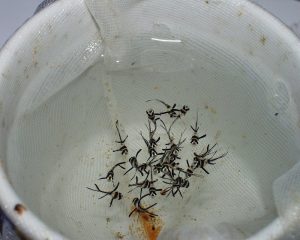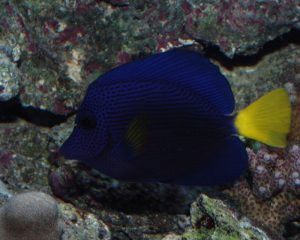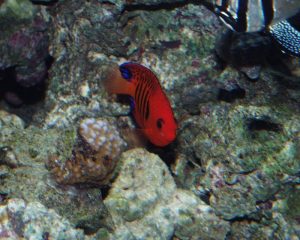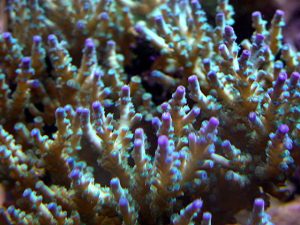I would like to thank the staff of Advanced Aquarist for selecting my reef tank to the list of other Featured Aquariums. I first started into this hobby back in 1985 with a 10 gallon tank and damsel fish. This all happened when I visited a new LFS with saltwater fish and was hooked. I had been keeping freshwater fish since I was 5 years old. At the time, the recommended saltwater tank setup was crushed coral and an undergravel filter. Time has brought change including the types of equipment that are available for this hobby. Our knowledge of the reef environment and the coral and fish has also increased which made propagating corals and breeding saltwater fish in our captive environment possible.
Through out my college years, I have always maintained a fish only tank as the only corals available were Condylactis anemones. As the variety of corals and different invertebrates increased, I decided to tear down my fish only tank and start over with the mind set of keeping live corals. By this time, I decided to also try my hands on a deep sand bed setup with more live rock. This was when I bought my first 50 gallon acrylic tank and had it setup for live corals. For the next 4 years, I had ups and downs with the tank. Then in 1997, a friend of mind introduced me to SPS keeping and that was when I realized that my entire setup needed to change again. I upgraded my lighting from NO lights to MH and VHO lamps. I also upgraded my skimmer to a more efficient model. As SPS became more available, I was running out of room and decided it was time to upgrade tanks again.
That was when the planning started. I measured the wall where the tank was going to set and made sure the floor would support the weight of the tank. I consulted with builders and also made lots of weight and floor stress analyses to conclude that my floor would be strong enough. Then I created a list of requirements in terms of live stock, how to circulate the tank and also the tank, hood and stand requirements. After 3 months of calculations and listing the requirements, I purchased my next upgrade, a 224 gal acrylic tank.
Configuration
The tank is 72″ L x 30″ W x 24″ H and has a center overflow box that is 13″ L x 10″ W. There are 3 openings on the top to give me room to put large rocks in the tank. The hood is custom made with 3 doors on the front and 1 door on each side, for each access into the hood and stand.
Aquascaping
The substrate is comprised of 5″ – 6″ CaribSea Seaflor Special Grade reef sand. I like this grade of sand mainly because it doesn’t get blown around in the water current and small enough so that I like the looks of it. I also have about 300 lbs of live rock from Fiji, Marshall Islands and Manano. The live rock is basically arranged to give maximum area for SPS frags and colonies.
Circulation
The tank’s circulation is generated by a Dolphin 3600 AquaSea equivalent pump. I chose this pump mainly because of the low noise output. One of the main goals for this tank is noise reduction and power consumption. There are no closed loops in this tank, mainly because I didn’t think about it. Water is basically pumped into the tank through 2 one inch Sea Swirls on each side of the tank. I wanted a rotating return to create random flow. Water is drained into the sump that was created from a used 85 gallon acrylic tank and I added baffles to the sump tank to prevent bubbles from returning to the main tank.
Water Filtration
I’ll have to admit that I do not use RO/DI water filtration as recommended by many reefers. My water is filtered using Poly-marine Kold Sterile. I decided against RO/DI unit as I could not come to terms with wasting more water than I created. The Kold Sterile unit is basically a 3 stage water filtration system. The first stage is comprised of a 12″ column that is made up of Poly filter discs, used to extract particulate impurities from your water. The second stage contains phosphate alumina that basically removes phosphates and the last stage is made up of carbon to absorb organic chemicals that are still present. The output is undetectable phosphate and the unit will produce up to 4.2 gpm. But I have the unit putting out 1.5 gpm, so the water will have more time through the filter media. The water filtration unit is connected to the house plumbing.
Top-Off Water
When I first set up the tank, I had to manually top off the tank with 30 gallons of water each week. It came to a point where I would forget to top off the tank. So I built a float switch/solenoid unit and have it hooked up to the water filtration unit. Once a week I monitor the salinity level so I know when to add more salt.
Calcium/Alkalinity Supplementation
To keep up with the demands of the SPS, I have the Precision Marine CS622 and use CaribSea ARM media to maintain the calcium and other trace elements. The bulb rate is set at 1-2 bubbles per second. I also have My Reef Creation Kalk Reactor hooked up to my top-off water to help maintain the pH.
Filtration
The tank filtration is no different than many tanks out there. From the overflow, the water goes through a blue/white poly filter pad to remove larger particles and the filter pad is changed weekly. The system uses the AquaC EV-200 protein skimmer to keep the water clean and clear. The protein skimmer is powered by a Custom Sealife T4 pump.
Lighting
The tank is lit by 4 x 400W metal halide (3 x Ushio 10000K and 1 x Venture 10000K) and 6 x 160W URI Super Actinic VHO bulbs. The 3 Ushio 10000K bulbs are running on a PFO 400W HQI ballast and the Venture 10000K is running on a PFO 400W M59 ballast. The 6 VHO bulbs are running off 3 IceCap 660 ballasts. The metal halide lights are on 9 hours a day set a different time intervals and the VHO bulbs are on 10 hours a day. At night when all the lights are out, I have 2 Custom Sealife Moonlights and 2 7W blue bulbs I bought from Lowes. The moonlights are on 9 hours after the main lights are out. All the lights are plugged into digital timers to prevent loss of time in the event of a power failure.
Maintenance
Every week I change out the filter pad to prevent nitrate build up. This also coincides with trash day. Every 2 months I do a 30 gallon water change and emergency water changes if the corals look like something is irritating them. I’ve started a new process where I am going to vacuum a small portion of my gravel to prevent detritus build up in my substrate, but this may go away in the future pending results.
Feeding
I feed my tank once a day with frozen brine shrimp and Cyclopeeze. Once a week I clip nori seaweed to the tank for the tangs and trigger.
Fish
I have not bought or acquired any new fish in the past year. The fish community includes a Marine Betta, Yellow Tang, Sailfin Tang, Hippo Tang, Purple Tang, Niger Trigger (named Pig), 2 breeding Bangaii Cardinals, 2 Yellow-Tail Damsels (oldest member of the tank – 7 years and going), Flame Angel, Midnight Angel, Algae Blenny, Fire Hawk, Pseudochromis, and Green Mandarin (4 years old).
Corals
The tank is mainly a SPS dominated tank with some zooanthids, mushrooms and soft corals. Here’s a quick list of the SPS that are in the tank:
Acropora List
- Tortuosa
- Hyacinthus
- Efflorences
- Nana
- Formosa
- Yongei
- Granulosa
- Speciosa
- Millipora
- Prostata

- Loisetteae
- Loripes
- Squarrosa
- Kimbeensis
Montipora List
Others
- Green Stylophora
- Pink Stylophora
Future Plans
After reading an article on DSB and the usefulness depth of the sand, I plan on slowly removing about 3″ – 4″ of sand from the tank, which should leave about 2″ of sand left in the tank. The advantage of this is, I’m only keeping enough sand to be effective and also this reduces the amount of weight to the setup. Other plans include adding more live rock to create additional space for more SPS.
To see more of my tank specification and pictures, you can visit my homepage at http://www.romperroo.com/FishCorner/FishCorner.htm.
Jim Huang, [email protected]





0 Comments